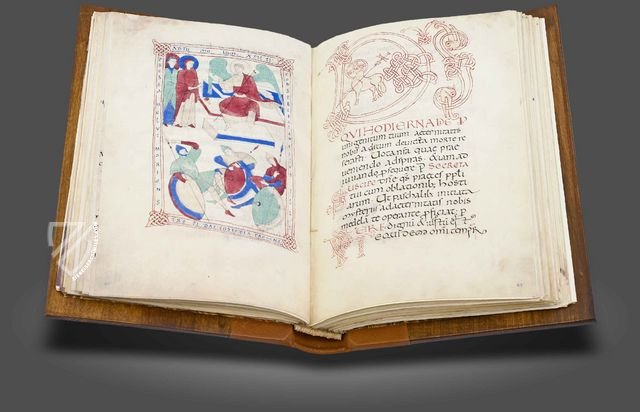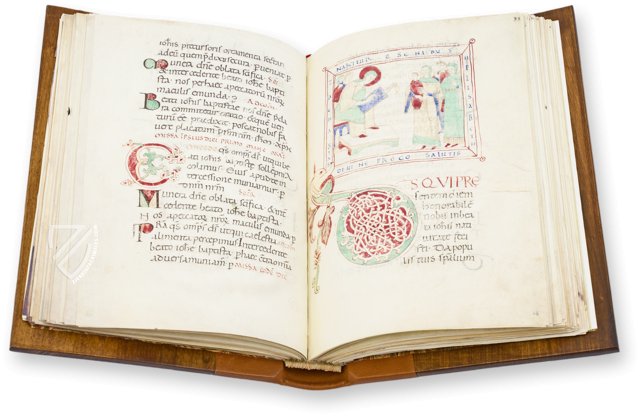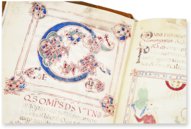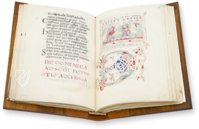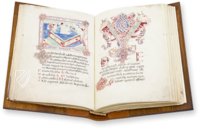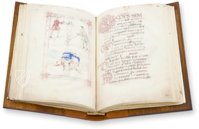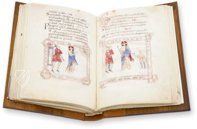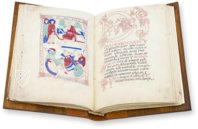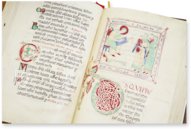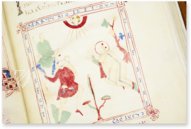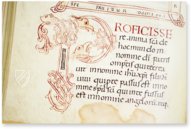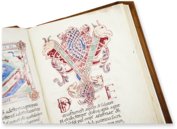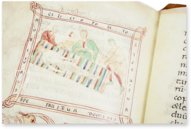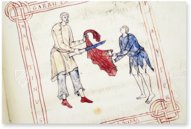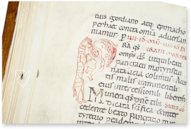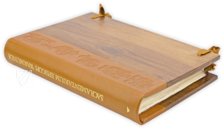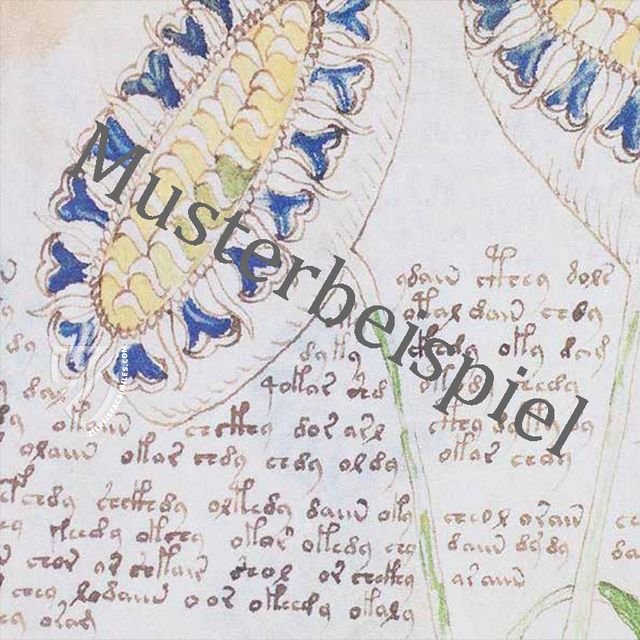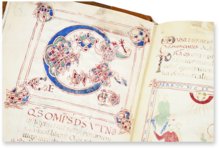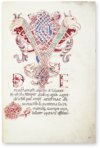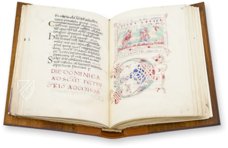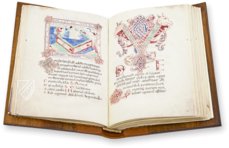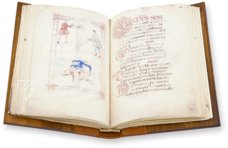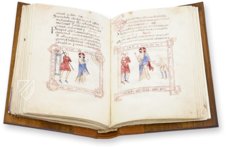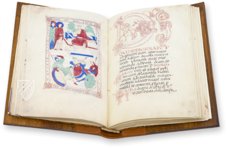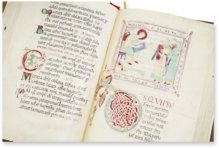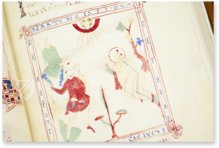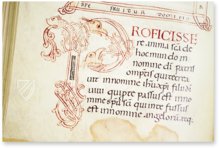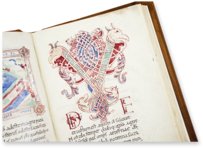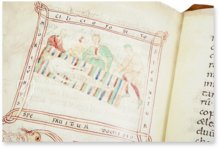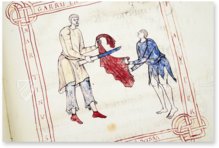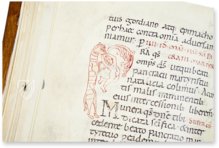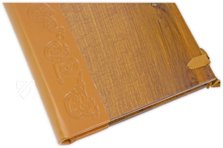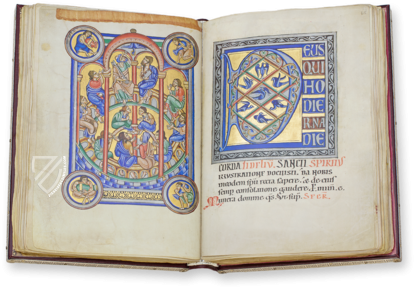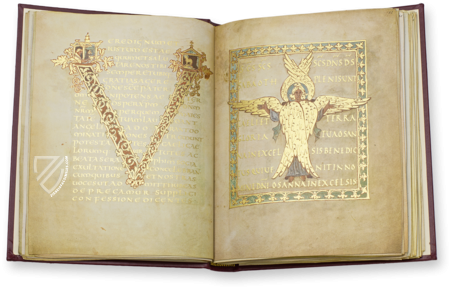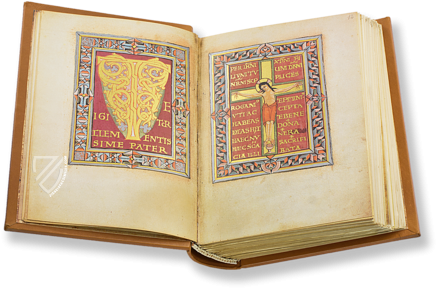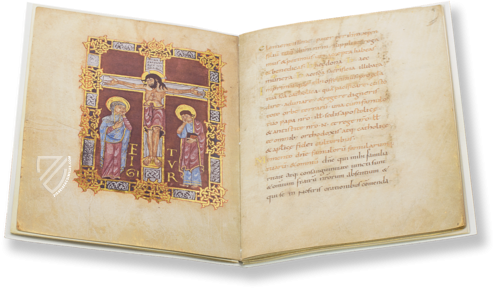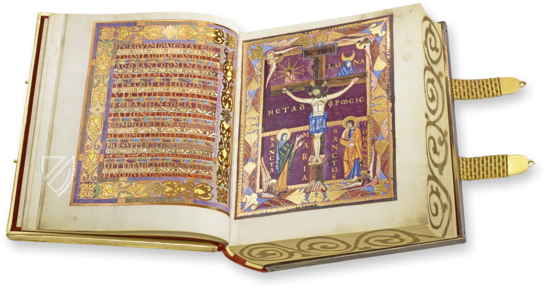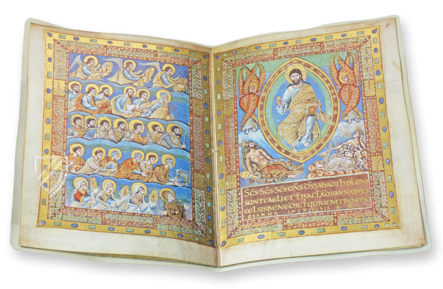Sacramentary of Warmund
(1,000€ - 3,000€)
Bishop Warmund of Ivrea (died ca. 1011) was an important ecclesiastical and political figure in early medieval Italy and the patron of numerous historical artistic treasures, only a few of which have survived to this day. One of his most spectacular legacies, the precious Sacramentary of Warmund, was created at the end of the 10th century. No less than five hands adorned the liturgical book containing the prayers for the masses throughout the liturgical year with countless wonderful decorated initials and a total of 62 subtly colored miniatures, making it the most extensively illuminated sacramentary of its time. Among them are rare biblical iconographies such as the naming of John the Baptist as well as scenes of the consecration of bishops and the anointing of kings. Elaborate and ornate interlace details appear throughout the manuscript, characterizing not only the composition of the often zoomorphic initials, but also embellishing many of the framings. A unique Ottonian book treasure!
Sacramentary of Warmund
A precious manuscript, which was manufactured before the year 1000, is stored in the Capitulary Library of the Italian city of Ivrea. It is the Sacramentarium Episcopi Warmundi, which was made for Bishop Warmund of Ivrea. The codex consists of 444 parchment pages altogether and contains illuminations of vastly varying execution as well as colored and gilded decorative initials. It is one of the oldest works of the ecclesiastical book collection.
A Historic Personality
Bishop Warmund played a special role in the history of the city of Ivrea. He was an opponent to the King of Ivrea at that time – King Arduino and defied his rule. His most famous supporter was the young Holy Roman Emperor Otto III. He had declared it his goal to restore the Holy Roman Empire as it existed under the Emperor Constantine. The Kaiser named Pope Sylvester II as the successor of Pope Gregory V. During the Roman synod in the year 999, he imposed the death penalty on the ostensibly godless King Arduino, removing Warmund’s enemy in doing so. The sacramentary, which was written in his honor, commemorates the conquest of an enemy.
A Worthy Opponent
Numerous depictions of King Arduino, who is often referred to in historical writings as the first King of Italy. He is depicted as a great man with a stately, powerful stature. His rival Warmund in no way failed to fulfill this ideal, or at least that is what the historical images of the Bishop would conclude. The highly-educated and art-loving Warmund transformed the city of Ivrea into one of the most important cultural centers of Italy during that historic epoch. One of the few examples of the artistic achievements of his time to survive today is the astounding sacramentary that lays before us.
Manifold Illumination
The illustration of the masterpiece was executed by various illuminators. However, a few special features are common in all of the pictures. The vividly colorful scenes were sketched with a pen and painted with water colors. The large-format miniatures as well as the finely designed decorative initials are encompassed in frames, which bear clarifying and explanatory inscriptions.
Codicology
- Alternative Titles
- Ivrea Sacramentary
Sacramentario del Vescovo Warmondo di Ivrea
Sacramentarium episcopi Warmundi
Bishop Warmund Sacramentary
Bischof Warmund-Sakramentar
Sacramentary of Ivrea
Sacramentario d'Ivrea
Episcopi Warmundi - Size / Format
- 444 pages / 33.6 × 24.3 cm
- Origin
- Italy
- Date
- End of the 10th century
- Epochs
- Style
- Language
- Script
- Carolingian minuscule
- Illustrations
- 62 miniatures and numerous colorful zoomorphic initials
- Content
- Liturgical texts, prayers for various feast days, funerary rites, texts for the ordination of bishops and the consecration of kings
- Patron
- Warmund, Bishop of Ivrea (d. ca. 1011)
- Artist / School
- Influences from Byzantine, Ottonian, and Carolingian art
- Previous Owners
- Bishop Warmund (d. ca. 1011)
Sacramentary of Warmund
Coronation of a King
This fine miniature shows a young king leaning forward to receive his crown while surrounded by tonsured priests, all wearing elaborate robes. The scene is presented without a background and the only indication that they are in a church comes from the altar, which is covered with a large cloth. The naturalistic posturing of the figures is advanced for the period – a sign of the emerging Romanesque style – and differs from the stiff forms that were common in the 10th century.
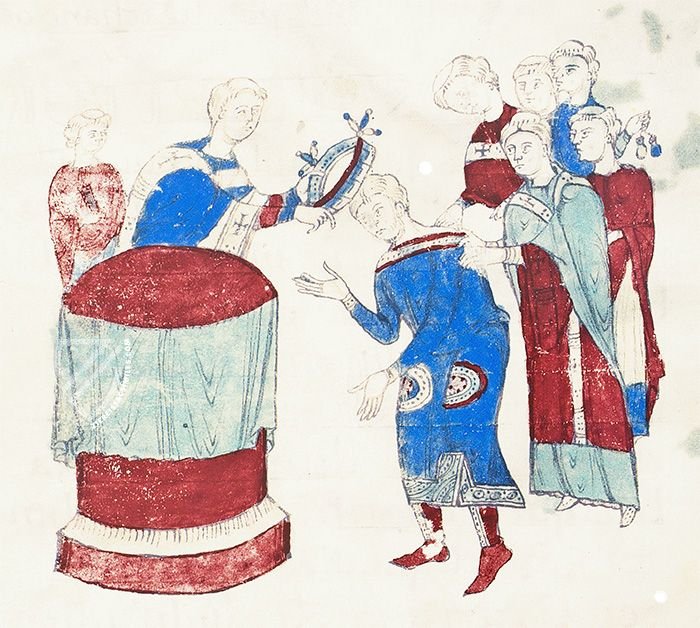
Sacramentary of Warmund
Incipit Page
Dominated by an elaborate “V” initial, this is a fine example of artwork in this thousand-year-old manuscript, which is distinguished by its embellished initials and fine watercolors. The watercolors would have been very bright when it was first made, but have unfortunately faded and the gold leaf has rubbed off over the centuries, but the red and blue have held up remarkably well.
The influence of Insular art was widespread in Europe at this time as Irish missionaries had been establishing monasteries across Europe for centuries and continued to be very active in monastic life, including the scriptoria. This influence is evident in the intricate interlace patterns and dragon heads, both standard features of Insular illumination.
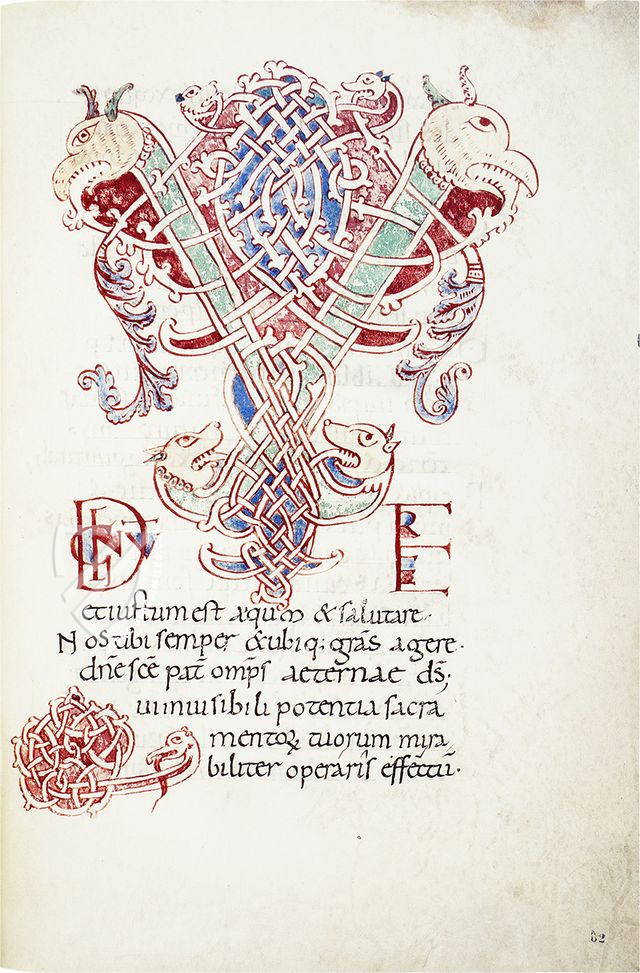
#1 Sacramentarium Episcopi Warmundi - Luxury Edition
Languages: English, French, Italian
(1,000€ - 3,000€)
#2 Sacramentarium Episcopi Warmundi - Standard Edition
Languages: Italian, English, French
The commentary comes in the same volume as the facsimile.
- Treatises / Secular Books
- Apocalypses / Beatus
- Astronomy / Astrology
- Bestiaries
- Bibles / Gospels
- Chronicles / History / Law
- Geography / Maps
- Saints' Lives
- Islam / Oriental
- Judaism / Hebrew
- Single Leaf Collections
- Leonardo da Vinci
- Literature / Poetry
- Liturgical Manuscripts
- Medicine / Botany / Alchemy
- Music
- Mythology / Prophecies
- Psalters
- Other Religious Books
- Games / Hunting
- Private Devotion Books
- Other Genres
- Afghanistan
- Armenia
- Austria
- Belgium
- Belize
- Bosnia and Herzegovina
- China
- Colombia
- Costa Rica
- Croatia
- Cyprus
- Czech Republic
- Denmark
- Egypt
- El Salvador
- Ethiopia
- France
- Germany
- Greece
- Guatemala
- Honduras
- Hungary
- India
- Iran
- Iraq
- Israel
- Italy
- Japan
- Jordan
- Kazakhstan
- Kyrgyzstan
- Lebanon
- Liechtenstein
- Luxembourg
- Mexico
- Morocco
- Netherlands
- Palestine
- Panama
- Peru
- Poland
- Portugal
- Romania
- Russia
- Serbia
- Spain
- Sri Lanka
- Sweden
- Switzerland
- Syria
- Tajikistan
- Turkey
- Turkmenistan
- Ukraine
- United Kingdom
- United States
- Uzbekistan
- Vatican City
- A. Oosthoek, van Holkema & Warendorf
- Aboca Museum
- Ajuntament de Valencia
- Akademie Verlag
- Akademische Druck- u. Verlagsanstalt (ADEVA)
- Aldo Ausilio Editore - Bottega d’Erasmo
- Alecto Historical Editions
- Alkuin Verlag
- Almqvist & Wiksell
- Amilcare Pizzi
- Andreas & Andreas Verlagsbuchhandlung
- Archa 90
- Archiv Verlag
- Archivi Edizioni
- Arnold Verlag
- ARS
- Ars Magna
- ArtCodex
- AyN Ediciones
- Azimuth Editions
- Badenia Verlag
- Bärenreiter-Verlag
- Belser Verlag
- Belser Verlag / WK Wertkontor
- Benziger Verlag
- Bernardinum Wydawnictwo
- BiblioGemma
- Biblioteca Apostolica Vaticana (Vaticanstadt, Vaticanstadt)
- Bibliotheca Palatina Faksimile Verlag
- Bibliotheca Rara
- Boydell & Brewer
- Bramante Edizioni
- Bredius Genootschap
- Brepols Publishers
- British Library
- C. Weckesser
- Caixa Catalunya
- Canesi
- CAPSA, Ars Scriptoria
- Caratzas Brothers, Publishers
- Carus Verlag
- Casamassima Libri
- Centrum Cartographie Verlag GmbH
- Chavane Verlag
- Christian Brandstätter Verlag
- Circulo Cientifico
- Club Bibliófilo Versol
- Club du Livre
- CM Editores
- Collegium Graphicum
- Collezione Apocrifa Da Vinci
- Comissão Nacional para as Comemorações dos Descobrimentos Portugueses
- Coron Verlag
- Corvina
- CTHS
- D. S. Brewer
- Damon
- De Agostini/UTET
- De Nederlandsche Boekhandel
- De Schutter
- Deuschle & Stemmle
- Deutscher Verlag für Kunstwissenschaft
- DIAMM
- Droz
- E. Schreiber Graphische Kunstanstalten
- Ediciones Boreal
- Ediciones Grial
- Ediclube
- Edições Inapa
- Edilan
- Editalia
- Edition Deuschle
- Edition Georg Popp
- Edition Leipzig
- Edition Libri Illustri
- Editiones Reales Sitios S. L.
- Éditions de l'Oiseau Lyre
- Editions Medicina Rara
- Editorial Casariego
- Editorial Mintzoa
- Editrice Antenore
- Editrice Velar
- Edizioni Edison
- Egeria, S.L.
- Eikon Editores
- Electa
- Emery Walker Limited
- Enciclopèdia Catalana
- Eos-Verlag
- Ephesus Publishing
- Ernst Battenberg
- Eugrammia Press
- Extraordinary Editions
- Fackelverlag
- Facsimila Art & Edition
- Facsimile Editions Ltd.
- Facsimilia Art & Edition Ebert KG
- Faksimile Verlag
- Feuermann Verlag
- Folger Shakespeare Library
- Franco Cosimo Panini Editore
- Friedrich Wittig Verlag
- Fundación Hullera Vasco-Leonesa
- G. Braziller
- Gabriele Mazzotta Editore
- Gebr. Mann Verlag
- Gesellschaft für graphische Industrie
- Getty Research Institute
- Giovanni Domenico de Rossi
- Giunti Editore
- Graffiti
- Grafica European Center of Fine Arts
- Guido Pressler
- Guillermo Blazquez
- Gustav Kiepenheuer
- H. N. Abrams
- Harrassowitz
- Harvard University Press
- Helikon
- Hendrickson Publishers
- Henning Oppermann
- Herder Verlag
- Hes & De Graaf Publishers
- Hoepli
- Holbein-Verlag
- Houghton Library
- Hugo Schmidt Verlag
- Idion Verlag
- Il Bulino, edizioni d'arte
- ILte
- Imago
- Insel Verlag
- Insel-Verlag Anton Kippenberger
- Instituto de Estudios Altoaragoneses
- Instituto Nacional de Antropología e Historia
- Introligatornia Budnik Jerzy
- Istituto dell'Enciclopedia Italiana - Treccani
- Istituto Ellenico di Studi Bizantini e Postbizantini
- Istituto Geografico De Agostini
- Istituto Poligrafico e Zecca dello Stato
- Italarte Art Establishments
- Jan Thorbecke Verlag
- Johnson Reprint Corporation
- Josef Stocker
- Josef Stocker-Schmid
- Jugoslavija
- Karl W. Hiersemann
- Kasper Straube
- Kaydeda Ediciones
- Kindler Verlag / Coron Verlag
- Kodansha International Ltd.
- Konrad Kölbl Verlag
- Kurt Wolff Verlag
- La Liberia dello Stato
- La Linea Editrice
- La Meta Editore
- Lambert Schneider
- Landeskreditbank Baden-Württemberg
- Leo S. Olschki
- Les Incunables
- Liber Artis
- Library of Congress
- Libreria Musicale Italiana
- Lichtdruck
- Lito Immagine Editore
- Lumen Artis
- Lund Humphries
- M. Moleiro Editor
- Maison des Sciences de l'homme et de la société de Poitiers
- Manuscriptum
- Martinus Nijhoff
- Maruzen-Yushodo Co. Ltd.
- MASA
- Massada Publishers
- McGraw-Hill
- Metropolitan Museum of Art
- Militos
- Millennium Liber
- Müller & Schindler
- Nahar - Stavit
- Nahar and Steimatzky
- National Library of Wales
- Neri Pozza
- Nova Charta
- Oceanum Verlag
- Odeon
- Orbis Mediaevalis
- Orbis Pictus
- Österreichische Staatsdruckerei
- Oxford University Press
- Pageant Books
- Parzellers Buchverlag
- Patrimonio Ediciones
- Pattloch Verlag
- PIAF
- Pieper Verlag
- Plon-Nourrit et cie
- Poligrafiche Bolis
- Presses Universitaires de Strasbourg
- Prestel Verlag
- Princeton University Press
- Prisma Verlag
- Priuli & Verlucca, editori
- Pro Sport Verlag
- Propyläen Verlag
- Pytheas Books
- Quaternio Verlag Luzern
- Reales Sitios
- Recht-Verlag
- Reichert Verlag
- Reichsdruckerei
- Reprint Verlag
- Riehn & Reusch
- Roberto Vattori Editore
- Rosenkilde and Bagger
- Roxburghe Club
- Salerno Editrice
- Saltellus Press
- Sandoz
- Sarajevo Svjetlost
- Schöck ArtPrint Kft.
- Schulsinger Brothers
- Scolar Press
- Scrinium
- Scripta Maneant
- Scriptorium
- Shazar
- Siloé, arte y bibliofilia
- SISMEL - Edizioni del Galluzzo
- Sociedad Mexicana de Antropología
- Société des Bibliophiles & Iconophiles de Belgique
- Soncin Publishing
- Sorli Ediciones
- Stainer and Bell
- Studer
- Styria Verlag
- Sumptibus Pragopress
- Szegedi Tudomànyegyetem
- Taberna Libraria
- Tarshish Books
- Taschen
- Tempus Libri
- Testimonio Compañía Editorial
- Thames and Hudson
- The Clear Vue Publishing Partnership Limited
- The Facsimile Codex
- The Folio Society
- The Marquess of Normanby
- The Richard III and Yorkist History Trust
- Tip.Le.Co
- TouchArt
- TREC Publishing House
- TRI Publishing Co.
- Trident Editore
- Tuliba Collection
- Typis Regiae Officinae Polygraphicae
- Union Verlag Berlin
- Universidad de Granada
- University of California Press
- University of Chicago Press
- Urs Graf
- Vallecchi
- Van Wijnen
- VCH, Acta Humaniora
- VDI Verlag
- VEB Deutscher Verlag für Musik
- Verlag Anton Pustet / Andreas Verlag
- Verlag Bibliophile Drucke Josef Stocker
- Verlag der Münchner Drucke
- Verlag für Regionalgeschichte
- Verlag Styria
- Vicent Garcia Editores
- W. Turnowski Ltd.
- W. Turnowsky
- Waanders Printers
- Wiener Mechitharisten-Congregation (Wien, Österreich)
- Wissenschaftliche Buchgesellschaft
- Wissenschaftliche Verlagsgesellschaft
- Wydawnictwo Dolnoslaskie
- Xuntanza Editorial
- Zakład Narodowy
- Zollikofer AG

